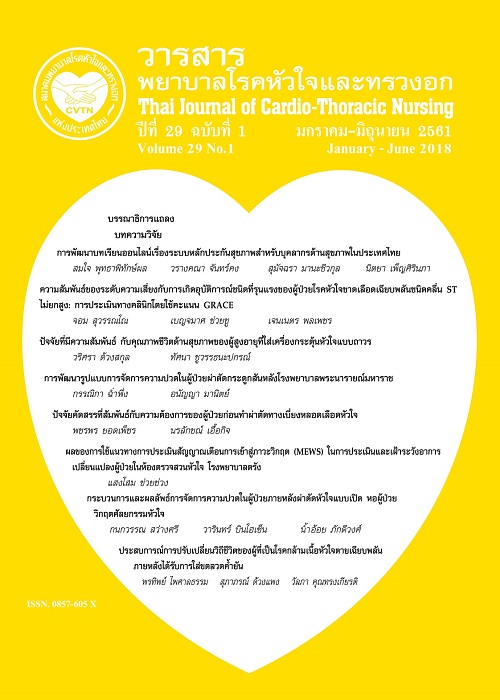Experiences of lifestyle modification among patient with acute myocardial infarction post Coronary stent placement
Keywords:
lifestyle modification experiences, patient with acute myocardial infarction, stent implantationAbstract
The purpose of this qualitative study was to describe experiences of lifestyle modification in patient with acute myocardial infarction post stent implantation. The key informants purposively selected in the study were fifteen patients with acute myocardial infarction post stent implantation required for follow-up at the Cardiovascular Center of the HRH Princess MaHa Chakri Sirindhorn Medical Center, Nakhonnayok province. Data were collected by using semi-structured and in-depth interviewing and observation during the interview. Content analysis method was used for data analysis.
The study revealed that the experiences of lifestyle modification in patient with acute myocardial infarction post stent implantation can be categorized into two themes: positive aspect as a help to normal life condition; and negative aspect as life condition limitations. The positive aspect describes 1) doing activities on regular basis and 2) doing some activities on regular basis. On the other hand, the negative aspect is related to 1) doing but giving up due to ineffectiveness and 2) doing activities only when any symptom occurred.
This study suggests that nurses and health care providers should understanding experiences of lifestyle modification in patient with acute myocardial infarction post stent implantation. How lifestyle modification they performed. This finding leads to improve quality of healthcare continuously in order to promote patients with acute myocardial infarction post stent implantation to enhance better lifestyle modification.
References
2. Bureau of Policy and Strategy Office of the Permanent Secretary Ministry of Public Health. Public health statistic. [Internet]. 2014. [Cited 2014 Oct 10]. Available from: http://bps.moph.go.th/new_bps/sites/default/files/health_statistics2555.pdf. (in Thai).
3. Spertus JA, Martha JR, Nathan RE, Edward FE, Erik DP, Harlan MK. Cardiovascular disease and stroke cardiology first scientific forum on quality of care and outcomes research in working group of the American heart association/American college of myocardial infarction; summary from the acute myocardial infarction. Circulation. 2003; 107:1681-91.
4. Kuanprasert S. Acute coronary syndrome. In: Sukonthasarn A, Kuanprasert S, editors. Coronary Artery syndrome (ACS). Chiang Mai: I Am Organizer; 2003. p. 221-36. (in Thai).
5. Kang SH, Park KH, Choi D, Park KW, Chung WY, Lim C. Coronary artery bypass grafting versus drug-eluting stent implantation for left main coronary artery disease (from a two-center registry). Am J Cardiol. 2010; 105:343-51.
6. Neville K, Youshinobu O, Patrick WS. Coronary Stent Technology. In: Haase J, Schafers HJ, Sievert H, Waksman R, editors. Cardiovascular interventions in clinical practice. Oxford. n.p.; 2010. p. 330-52.
7. Benjanuwattra T, Sukonthasarn A. Percutaneous transluminal coronary angioplasty. In: Sukonthasarn A, editors. Coronary Artery Disease. Chiang Mai: Identity Group; 2005. p. 55-90. (in Thai).
8. Whooley, MA, Jonge PD, Vittinghoff E, Otte C, Carney RM, Ali S, et al. Depressive symptoms health behaviors, and risk of cardiovascular event in patients with coronary heart disease. JAMA. 2008; 300(20):2379-88.
9. Lucai A, Dieter M, Klaus L. Multifactorial lifestyle intervention in the primary and secondary prevention of cardiovascular disease and Type 2 diabetes mellitus-a systematic review or randomized controlled trials. Ann Behav Med. 2010;40:49-64.
10. Suwannasri S. Self-care behaviors of myocardial infarction patients before and after discharge from the hospital to home [Master Thesis of Nursing Science]. Khon Kaen: KhonKaen University; 2005. (in Thai).
11. Voranun P. Health behaviors of patients with coronary artery disease post percutaneous transluminal coronary angioplasty [Thesis of Master degree of Nursing Science]. Bangkok: Mahidol University; 1998. (in Thai).
12. Dakhunthod T. The effect of self-efficacy cardiac rehabilitation program on the exercise and activity in coronary artery disease patients [Master Thesis of Nursing Science]. Khon kaen: Khon Kaen University; 2006. (in Thai).
13. Vantanasin S, Self-care deficit in coronary heart disease patients. The Journal of Faculty of Nursing, Burapha University 2000; 7:58-65. (in Thai).
14. Thanakitworabool J. Recovery health behaviors of patient with post-acute myocardial infarction at Thamaung Hospital in Kanchanaburi Province [Master Thesis of Nursing Science]: Nakhonpathom: Christian University; 2011. (in Thai).
15. Kaewon W. Perception about illness and information regarding self care of patients with coronary artery disease underwent coronary artery intervention [Master Thesis of Nursing Science]. Khon Kaen: Khon Kaen University; 2009. (in Thai).
16. Tumnong C. Illness experience of patients with ischemic heart disease [Doctor of Nursing Science]. Bangkok: Mahidol University; 1998. (in Thai).
17. Miller P, Wikoff R, McMahon M, Garrett MJ, Ringel K. Regimen compliance two years after myocardial infarction. Nurs Res. 1990;39:333-6.
18. Lincoln YS, Guba EG. Naturalistic Inquiry. Philadelphia: SAGE; 1985.
19. Chantavanich S. Qualitative Research. 20thed. Bangkok: Chulalongkorn University Press; 2012. (in Thai).
20. New York Heart Association. Nomenclature and criteria for diagnosis of diseases of the heart and great vessels. 9th ed. Boston: Little, Brown & Co; 1994.
21. Srijun K. Experiences of unplanned percutaneous coronary intervention in patients with acute myocardial infarction [Thesis of Master of Nursing Science]. Songkla: Prince of Songkla University; 2009. (in Thai).
22. Pipatsombut P. Factors associating with self-care behavior among patients seeking percutaneous coronary intervention and stent at Bangkok Metropolitan Administration Medical College and Vajira Hospital [Master of Science]. Bangkok: Kasetsart University; 2003. (in Thai).
23. Homtong W. Health behaviors among persons with coronary artery disease readmission at Nakornping Hospital [Master Thesis of Nursing Science]. Chiang Mai: Chiang Mai University; 2004. (in Thai).
24. Sookprasert N. Factors related to functional performance among persons with myocardial infarction [Master Thesis of Nursing Science]. Chonburi: Burapha University; 2015. (in Thai).
25. Jeiwsubpong W. The relationship between personal factors, severity level, depression social support and functional status of myocardial infarction patients in Nakohn sawan province [Master Thesis of Nursing Science]. Chonburi: Burapha University; 2007. (in Thai).
Downloads
Published
How to Cite
Issue
Section
License
บทความนี้ยังไม่เคยตีพิมพ์หรืออยู่ในระหว่างส่งไปตีพิมพ์ในวารสารอื่น ๆ มาก่อน และกองบรรณาธิการขอสงวนสิทธิ์ในการตรวจทาน และแก้ไขต้นฉบับตามเกณฑ์ของวารสาร ในกรณีที่เรื่องของท่านได้ได้รับการตีพิมพ์ในวารสารฉบับนี้ถือว่าเป็น ลิขสิทธิ์ของวารสารพยาบาลโรคหัวใจและทรวงอก






